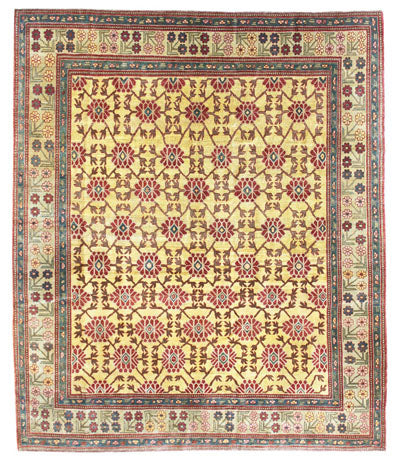
J24351, 5’ 5" X 8’ 0", Hand-knotted in Turkey
Many of the rugs being woven today use traditional designs. Although Persian rugs form the most important source of the traditional designs, there are others. One of the most intriguing sources are the three towns on oases on the old Great Silk Road. Although we frequently refer to these designs as “Khotan”, all three towns, Khotan, Yarkand, and Kashgar wove rugs. What makes these interesting is antiquity and complexity of design. The desert climate has preserved rug fragments almost 2,000 years old. Being in the major east-west trade route, Khotan designs reflect influences from Persia, China, and India. Also, they add a local touch by frequently including pomegranates in the design. The following blog article provides a nice summary of the history and rugs of this area: http://tea-and-carpets.blogspot.com/2010/11/khotan-carpets-and-lost-legacy-of-silk.html.
Below are images of some rugs in our inventory. Some are close representations of Khotan designs, others show various degrees of influence.
 J27968, 9’ 0" x 11’ 5", Hand-woven in Turkey
J27968, 9’ 0" x 11’ 5", Hand-woven in Turkey
 J24672, 8’ 3" x 9’ 7", Hand-woven in Pakistan
J24672, 8’ 3" x 9’ 7", Hand-woven in Pakistan
 J21630, 4’ 1" x 5’ 1", Hand-woven in Turkey
J21630, 4’ 1" x 5’ 1", Hand-woven in Turkey
 J24353, 1’ 10" x 11’ 10", Hand-woven in Turkey
J24353, 1’ 10" x 11’ 10", Hand-woven in Turkey
 J24349, 4’ 10" x 6’ 10", Hand-woven in Turkey
J24349, 4’ 10" x 6’ 10", Hand-woven in Turkey
 J25149, 8’ 0" x 9’ 7", Hand-knotted in Turkey
J25149, 8’ 0" x 9’ 7", Hand-knotted in Turkey

